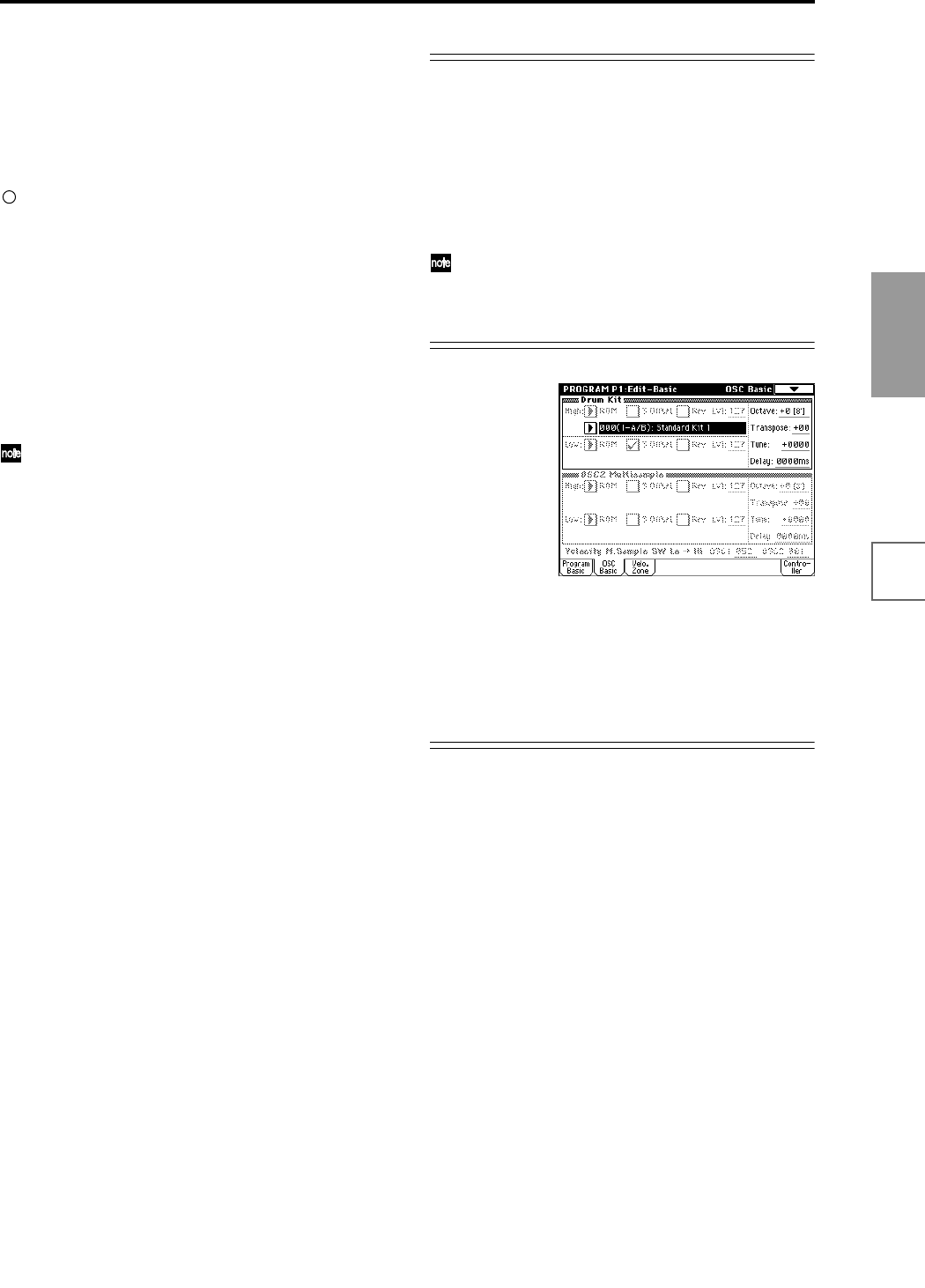
69
Basic functions
Saving dataLoading dataProgram
settings
Combination
settings
Producing
songs
Sampling
settings
Creating a
CD
SMF
playback
System
settings
Drum kit
settings
Arpeggiator
settings
Effects
settings
Other
functions
Additional multisamples can be added by installing EXB-
PCM series options. Data sampled on the TRITON STU-
DIO can also be used as a multisample.
Selecting a multisample
The multisample will determine the basic character of the
program.
Use “High MS Bank” to select the multisample bank,
and use “High Multisample” to select the multisam-
ple.
If the “High MS Bank” is ROM, you can select preset
multisamples. “High Multisample” can be selected
from a range of 000–424. (☞VNL)
If “High MS Bank” is RAM, you can select multisam-
ples that were sampled on the TRITON STUDIO or
loaded in from media. Select from 000–999 for “High
multisample.”
If “High MS Bank” is Piano, you can select one of the
large preset piano multisamples. Select from 000–003
for “High Multisample.”
If “High MS Bank” is set to ROM, pressing the
“High Multisample” popup button will display all
internal ROM multisamples, organized into 15 cate-
gories. Use the tabs located at the left and right to
select the desired category, and select a multisample
from within that category.
High Multisample and Low Multisample
If you specify a High and Low multisample for an oscilla-
tor, either the High or the Low multisample will sound
depending on the velocity of the note (i.e., the strength at
which you play the keyboard). This function is called
velocity multisample switching.
1 Specify different multisamples for “High Multisam-
ple” and “Low Multisample.”
2 Specify a velocity value for “Velocity M.Sample SW
Lo→Hi.”
Notes played on the keyboard at a velocity less than
the value you specify will sound the Low multisample;
velocities at or above this velocity value will sound the
High multisample.
For example if you set “Velocity M.Sample SW
Lo→Hi” to 100, playing the keyboard softly will sound
the “Low multisample,” and playing strongly will
sound the “High multisample.”
3 Adjust the “Lvl” (Level) for High and Low multisam-
ples to set their volume balance.
If you do not wish to use this function, set the “Veloc-
ity M.Sample SW Lo→ Hi” value to 001. Only the
High multisample will sound.
Rev (Reverse) check box
If this is checked, the multisample will be played back-
ward. This can produce interesting results when used on
sound-effects, etc. Normally you will not check this.
When “Oscillator Mode” = Double
To use OSC2, set “Oscillator Mode” to Double in the Pro-
gram Basic page.
In the same way as for OSC1, you can set High and Low
multisamples for OSC2.
The playback pitch can be set independently. By using the
same multisample with slightly different “Tune” settings,
you can “detune” the oscillators to produce a richer
sound.
It will be convenient to use the page menu command
“Copy Oscillator” to make the oscillator settings
match each other.
When “Oscillator Mode” = Drums
In the Program Basic page, set “Oscillator Mode” to
Drums. When this is set to Drums, you will be able to cre-
ate a drum program.
This will select a drum kit instead of a multisample. TRI-
TON STUDIO provides twenty factory preset drum kits
that are suitable for a wide variety of music. (☞VNL)
Here you can only select a drum kit. To edit or create a
drum kit, use Global P5: Drum Kit (☞p.128).
The following multisamples or drum kits can be used for
the oscillator.
• 425 internal multisamples (ROM)
• Multisamples that you sampled (RAM)
(Programs can be created from multisamples/samples
that you sampled in Sampling mode etc. or loaded
from media in Disk mode.)
• Four internal piano multisamples (Piano)
• Expansion multisamples (if a EXB-PCM option is
installed)
• Nine internal drum kits (ROM)
• 144 user drum kits created in Global mode
(Drum samples can be freely assigned to each key to
create a drum kit. For the sound of each key, you can
make filter and amp settings, and specify routing to the
effects and to the individual audio outputs.)


















